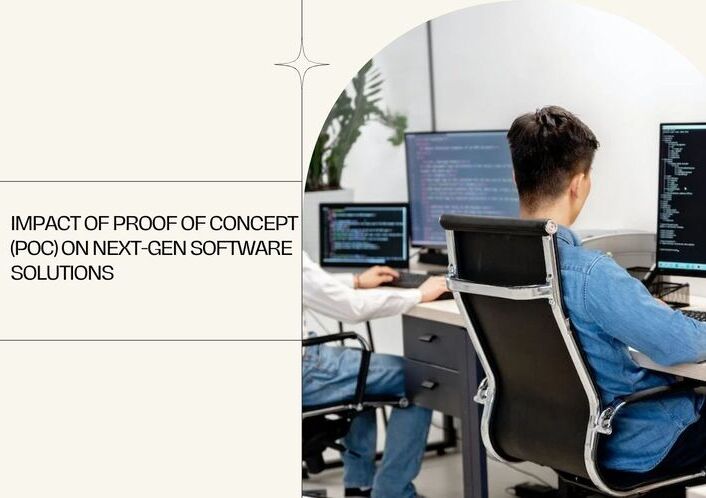Exploring the Impact of Proof of Concept on Next-Gen Software Solutions

In the constantly changing world of software development, staying ahead means innovation with practical application. What is Proof of Concept (PoC) – a linchpin in next-generation software solution development? PoC is not just an academic exercise. It demonstrates that innovative ideas are indeed doable and valuable before a huge investment is made. This article explores how PoC is changing the face of software development as it continues to evolve.
Understanding Proof of Concept (PoC): Unveiling the Essence
The Proof of Concept (PoC) is the first step in the intricate labyrinth of product development. It’s where imaginative ideas are put through their paces, firmly shaken out and scrutinized. Its core function is to demonstrate the practicability and actuality of immature concepts, carefully integrating them with those of market needs and technical capabilities that are constantly diverging.
PoC is a barrier between abstract sophistication and practical application. That’s the point where abstract notions are sculpted into realistic possibilities. PoC plays two roles: the first is that of referee, standing between abstract theory and practical reality; by subjecting these concepts to rigorous examination and testing. Through this process, PoC determines whether an idea has a chance of becoming a cutting-edge technology.
This crucial step in the development of products plays the role of a filtering screen, handpicking those winning ideas that would be practical to develop further into concrete solutions. Vetting concepts is only the first step; finding solutions to problems and sculpting the trajectory of future advancements must be conducive to market needs and at the same time fit with technological possibilities.
1. Navigating Industry Challenges: PoC as a Strategic Tool
The software industry is a complex tapestry overflowing with uncertainties and sudden shifts. Proof of Concept (PoC) becomes an indispensable strategic pillar, capable of coping with and ameliorating risks born with the nature of standing between success and failure. The significance of it, rather, lies in its ability to test the accuracy and effectiveness of innovative concepts early, forming a wall against costly missteps and wasteful resource allocation.
By subjecting concepts to rigorous scrutiny in the PoC phase, the industry gains a crucial advantage: to single out possible pitfalls and shortcomings before large investments are made. Preemptive identification of these shortcomings, however, doesn’t just prevent failure but redefines it. Within PoC, failures become springboards for the process. There is a culture of defeat when difficulties are opportunities to learn; within the ecosystem, there exists adaptation to change.
PoC’s part in saving resources, however crucial cannot be understated. The result is that companies are encouraged to invest knowingly. They direct investment money into concepts with promise and away from those whose value has been tested, and all this before the product has even reached the market much less become publicly available as a commercial reality. With resources used in this strategic manner, there is established an atmosphere that encourages experimentation, with its attendant risks. The result over the long run is to guarantee innovative energy and industry growth.
2. PoC: A Catalyst for Innovation
Proof of Concept is not just about risk reduction in the software industry; it spurs innovation. That’s where PoC comes in. Its strength lies in establishing a culture of exploration and learning, it establishes a safe space that allows airing of different possibilities without the burdensome weight involved when one has to make a real commitment.
This kind of controlled experimentation, encouraged by PoC, promotes a mindset that puts as much emphasis on what was learned from failure and disappointment as the joy of seeing an idea successful. It creates an environment in which innovative thinking is treasured so that teams can conduct experiments and try new ways of doing things without fearing immediate penalties. This atmosphere fosters creativity and curiosity, two key elements of breakthroughs.
The iterative manner of PoC is its unique characteristic. It enables an ongoing cycle of improvement based on experience drawn from each run. In this repeated cycle of ideation, disruption is envisioned to promote daring, game-changing solutions that transcend ingrained norms and bring about breakthroughs for the industry.
3. Enhancing Decision-Making: The PoC Advantage
Data obtained from PoC experiments is an important cornerstone for decision-making. It gives stakeholders a clear idea of the feasibility and potential of an idea or concept. With this empirical underpinning, discussions do not simply remain at the level of speculative debate but become deliberations backed by facts. Consensus and clarity in decision-making are thus achieved.
In addition, PoC’s ability to prove or disprove the assumptions guiding the direction of a project plays an increasingly decisive role. It eliminates ambiguity. Stakeholders can use data rather than having to rely on intuition or conjecture alone. The injection of empirical evidence adds confidence to the process of deciding, reducing uncertainties, and raising success rates.
From the perspective of a more effective decision-making framework, PoC not only helps to shorten development time but also increases resource efficiency. This provides stakeholders with the ability to base their decisions on concrete data, making them more strategic and goal-directed.
4. Fostering Collaboration and Streamlined Operations
Proof of Concept (PoC) has a defining characteristic–collaboration. Its role is to be the cementing force, bringing together myriad groups from a range of professions and backgrounds allowing space for cross-disciplinary dialogue.
The key to taking this synergistic approach is in the art of channeling together a large number of different individuals, each with their unique capabilities and attributes, toward one single objective. Diverse skill sets and different knowledge domains are woven together into a gorgeous tapestry of ideas and techniques. Not only does it speed up the process of solving problems, but also develops a culture that encourages creativity and wild solutions.
5. Looking Ahead: Evolving Dynamics of PoC
Just as the technological landscape, undergoes a period of earthquakes, so does PoC. Efforts to transform itself amid technological advances such as Artificial Intelligence (AI), blockchain, and the Internet of Things (IoT) will determine its future. PoC methodologies are on the verge of a major innovation, becoming modular and flexible in response to market changes.
The combination of PoC with these new technologies opens up an entirely new landscape, giving birth to innovative and cutting-edge software products that are capable of adapting to the changing times of our technology-driven society.

Pranab Bhandari is an Editor of the Financial Blog “Financebuzz”. Apart from writing informative financial articles for his blog, he is a regular contributor to many national and international publications namely Tweak Your Biz, Growth Rocks ETC.








